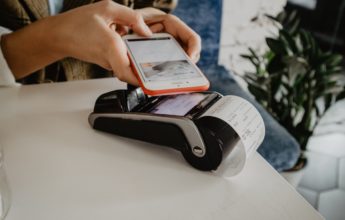Apple Pay launched in 2014 as the first mobile wallet, which enables people to connect credit cards, debit cards, and bank accounts to mobile devices to send and receive money. Out of the cornerstone mobile wallet services today (Google Pay, Samsung Pay, and Apple Pay), the Apple wallet remains the largest, claiming 34 percent of the market share.
This article offers an overview of Apple Pay, how it works, the market outlook, and reasons you should consider integrating the payment service in your mobile application.
What is Apple Pay?
Apple Pay is a mobile wallet service that facilitates mobile payments or regulated transactions from an iOS device. Apple Pay works on the iPhone (version 6 or newer) and the Apple Watch and Mac operating systems. To make a payment with Apple Pay, users add credit cards, debit cards, or prepaid cards to the Wallet app on their device, which allows them to make contactless payments in stores, in apps, on the web, or anywhere an Apple Pay badge is present. To complete payments, users can use Face ID, Touch ID, or a passcode to authenticate the purchase.
Is Apple Pay Secure?
Apple Pay allows users to make frictionless, secure, and private transactions. Specifically, Apple Pay leverages security features built-in to the hardware and software of iOS devices to help protect transactions. Apple doesn’t store or even have access to a user’s original credit, debit, or prepaid card information. Apple doesn’t save any transaction history, either. When a user adds their banking credentials, Apple decrypts the data, determines the card’s payment network, and re-encrypts the data with a key that only the user’s payment network, bank, the bank’s authorized service provider, or card issuer can unlock.
To securely transmit payment information when a user makes a purchase in an app or on the web, Apple Pay receives the encrypted transaction and re-encrypts it with a developer-specific key before the transaction information is sent to the developer or payment processor. This key ensures that only the app or website the user is purchasing from can access the encrypted payment information. Additionally, websites are required to verify their domain whenever they offer Apple Pay as a payment option.
The Apple Pay Market Outlook
According to eMarketer, Apple Pay’s dominance, as well as the increase in retailer adoption of proximity payment technology, is driving transaction volume in the United States. eMarketer estimates that proximity mobile payment transactions will total $98.88 billion in 2019, growing 31.8 percent to $130.36 billion next year. By 2021, the total transaction value will reach $161.41 billion.
Much of this growth is a credit to Apple Pay, which currently captures the largest share of the proximity mobile payment market in the United States. Additionally, this is the first time a universal mobile payment app has surpassed the Starbucks mobile app, which had long led the category despite being specific to one retailer. Apple Pay became the market leader last year when 27.7 million Americans used the app to make a purchase.
User adoption of mobile proximity payments is also witnessing favorable projections. As of 2019, there are 441 million Apple Pay users worldwide.
Source: Statista
Further research estimates that roughly 80 million U.S. users will access mobile payments in 2023, up from 69.4 million in 2020.
Where and how consumers make purchases has dramatically evolved—from walking into a store to shopping online using smartphones, tablets, and wearable devices. Connected devices and the commerce they enable are becoming increasingly integral to consumers’ willingness to pay for purchases. As Apple Pay continues to grow in popularity, there are plenty of reasons to integrate the payment option into an app. Many colossal brands from Airbnb, Etsy, Ticketmaster, Target, Lululemon, and countless others have already made Apple pay an opportunity for consumers. Let’s look more closely at the reasons Apple Pay is a smart integration for a mobile app.
Three Reasons You Should Offer Apple Pay in Your App
-
Consumers Have New Shopping Behaviors
Connected devices give consumers the freedom to shop anytime, anywhere — and now while doing anything. Convenience and saving time drive those behaviors, allowing consumers to “multitask commerce” as part of their everyday lives. A research study from PYMNTS, in collaboration with Visa, discovered that respondents reported making purchases while carrying out daily activities like commuting, cooking, and even exercising, many doing so while using connected devices such as smartphones, tablets, computers, wearables or voice-activated devices. In fact, across the group of respondents, more than three-quarters of consumers (76 percent) made purchases during at least one of their everyday activities, every day.
Most impressive is the very long tail of activities that defines the connected consumer’s daily journey. PYMNTS found that no one consumer follows the same path, though there are some common threads: making purchases while paying bills (39 percent), eating lunch (34 percent), eating dinner (27 percent), and browsing the internet (33 percent). Connected commerce creates an environment of serendipity for consumers — shoppable moments, whatever the device, whatever the time and whatever a consumer happens to be, and sellable moments for merchants.
-
The Home is Now a Commerce Hub
Devices that connect to the internet give consumers more options to do things at home that they once could do only while away from it. Connected devices also make “going shopping” at a store that consumers can choose to but don’t have to buy things.
Connected devices not only give consumers more opportunities to make purchases during the course of their day-to-day activities, but also give consumers more options to do so while at home. Specifically, purchasing while watching TV has increased by 19 percent (from 12.2 percent to 14.5 percent), while eating dinner has increased 4.9 percent (from 14.4 percent to 15.1 percent) between 2018 and 2019.
-
Extend the Value of Your Loyalty Programs
Most customers will not download a brands’ mobile apps, so business owners and marketers need to smartly leverage the mobile ecosystem to borrow mobile moments from the popular apps that their customers already use every day. Mobile Wallets and such apps.
A consumer can still use Apple Wallet even if they’re not using Apple Pay to make purchases. Brands can leverage Apple Wallet by creating Passes for loyalty cards. Passes are digital representations of information that might otherwise be printed on small pieces of paper or plastic. They let users take action in the physical world. Passes can contain images and a barcode, and passes can be updated at any time. A user views and manages their passes using the Wallet app. Passes can be used to check-in for flights, get and redeem rewards, get into movies, or redeem coupons. Passes can include useful information like the balance on your coffee card, membership tier and points, your coupon’s expiration date, your seat number for a concert, and more.
Final Thoughts
It is increasingly clear that, for many consumers, connected devices’ primary benefit lies in their ability to provide secure, ubiquitous, and universal access to retail goods and services, anywhere, anytime and now while doing anything. The future belongs to brands that can create use cases so compelling that consumers barely even notice that they’re engaging in commerce while using them at all. Apple Pay integrations will play a massive role in this shift by creating seamless checkout experiences and simplifying the purchase path.




